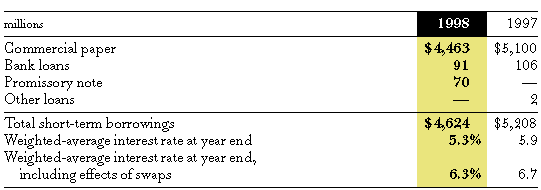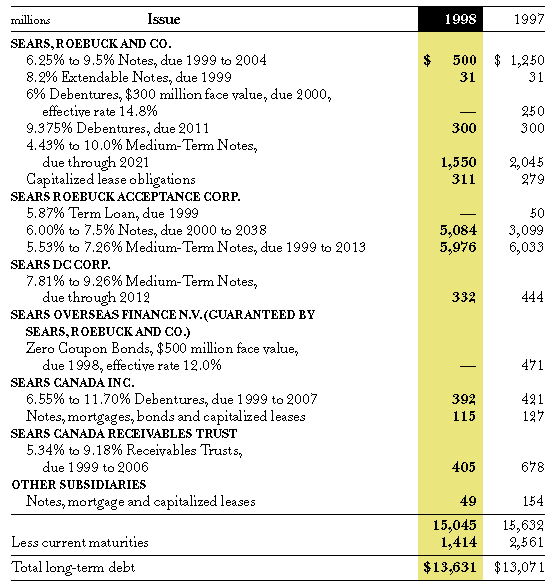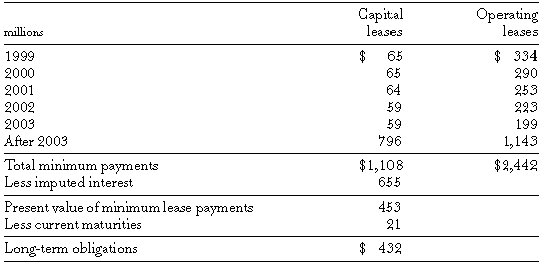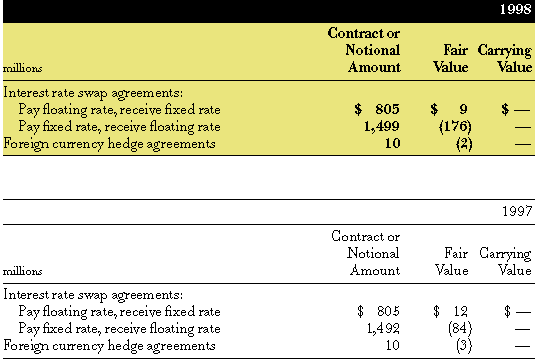 |
|
6. BORROWINGS
 At January 2, 1999, the Company had credit agreements totaling $6.62 billion. SRAC's credit facilities totaled $6.105 billion in syndicated credit agreements. Sears Canada had credit agreements totaling $523 million. These syndicated and other credit agreements provide for loans at prevailing interest rates and mature at various dates through April 2003. The Company pays commitment fees in connection with these credit agreements. The Company had interest rate swap agreements that established fixed rates on $1.50 billion and $1.49 billion of short-term variable rate debt at January 2, 1999 and January 3, 1998, respectively, resulting in weighted-average interest rates of 6.8% and 6.9%, respectively. The weighted-average maturity of agreements in effect on January 2, 1999, was approximately 14 years. Long-term debt is as follows:
 On October 2, 1998, the Company prepaid the 6% debentures with a face value of $300 million, which were due in May 2000. The transaction generated an extraordinary loss of $37 million and a related income tax benefit of $13 million, resulting in an after-tax loss of $24 million. The loss resulted primarily from the write-off of the related unamortized discount. The debt was refinanced with the issuance of commercial paper. During 1998, the Company also prepaid at par value the 5.87% term loan of $50 million which was due in 1999. As of January 2, 1999, long-term debt maturities for the next five years are as follows:
 The Company paid interest of $1.3, $1.4 and $1.3 billion in 1998, 1997 and 1996, respectively. Interest capitalized was $5, $3 and $5 million in 1998, 1997 and 1996, respectively. 7. LEASE AND SERVICE AGREEMENTS Operating and capital lease obligations are based upon contractual minimum rates and, for certain stores, amounts in excess of these minimum rates are payable based upon specified percentages of sales. Contingent rent is accrued over the lease term, provided that the achievement of the specified sales level that triggers the contingent rental is probable. Certain leases include renewal or purchase options. Operating lease rentals were $431, $439 and $365 million, including contingent rentals of $55, $57 and $66 million in 1998, 1997 and 1996, respectively. Minimum lease obligations, excluding taxes, insurance and other expenses payable directly by the Company, for leases in effect as of January 2, 1999, are as follows:
 The Company has committed to purchase data and voice networking and information processing services of at least $216 million annually through 2004 from a third-party provider. Total expenses incurred by the Company for these services during 1998, 1997 and 1996 were $355, $361 and $327 million, respectively. 8. FINANCIAL INSTRUMENTS To determine fair value, credit card receivables are valued by discounting estimated future cash flows. The estimated cash flows reflect the historical cardholder payment experience and are discounted at market rates. Long-term debt is valued based on quoted market prices when available or discounted cash flows, using interest rates currently available to the Company on similar borrowings. The Company is a party to off-balance sheet financial instruments to manage interest rate and foreign currency risk. These financial instruments involve, to varying degrees, elements of market, credit, foreign exchange and interest rate risk in excess of amounts recognized in the balance sheet. The Company generally does not require collateral or other security to support the off-balance sheet financial instruments with credit risk. Debt-related
 The Company uses interest rate swaps and caps to manage the interest rate risk associated with its borrowings and to manage the Company's allocation of fixed and variable-rate debt. For pay floating rate, receive fixed rate swaps, the Company paid a weighted-average rate of 5.63% and received a weighted-average rate of 6.81% in 1998. For pay fixed rate, receive floating rate swaps, the Company paid a weighted-average rate of 6.90% and received a weighted average rate of 5.64% in 1998. The fair values of interest rate swaps are based on prices quoted from dealers. If a counterparty fails to meet the terms of a swap agreement, the Company's exposure is limited to the net amount that would have been received, if any, over the agreement's remaining life. Maturity dates of the off-balance sheet financial instruments outstanding at January 2, 1999 are as follows:
 During 1997, the Company paid $633 million to terminate interest rate swaps. The deferred loss related to these terminations was $441 million and $464 million at January 2, 1999, and January 3, 1998, respectively, and is being amortized over the remaining lives of the original swap periods. Credit-related Other 9. SIGNIFICANT GROUP CONCENTRATIONS OF CREDIT RISK
 |
Annual Report Contents | Previous | Next | |